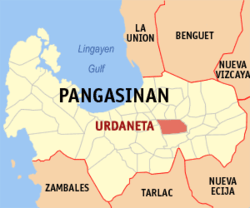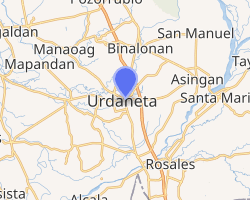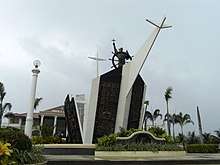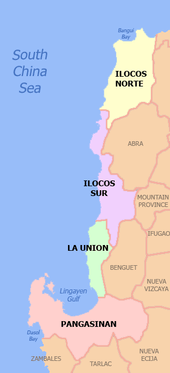Urdaneta, Pangasinan
Urdaneta, officially the City of Urdaneta (Pangasinan: Siyudad na Urdaneta; Ilocano: Siyudad ti Urdaneta; Tagalog: Lungsod ng Urdaneta), is a 2nd class city in the province of Pangasinan, Philippines. According to the 2015 census, it has a population of 132,940 people.[3]
Urdaneta | |
|---|---|
| City of Urdaneta | |
 Flag  Seal | |
| Motto(s): Deo servire populo sufficere | |
 Map of Pangasinan with Urdaneta highlighted | |
OpenStreetMap 
| |
.svg.png) Urdaneta Location within the Philippines | |
| Coordinates: 15°58′34″N 120°34′16″E | |
| Country | |
| Region | Ilocos Region (Region I) |
| Province | Pangasinan |
| District | 5th district |
| Founded | 1858 |
| Cityhood | March 21, 1998 |
| Barangays | 34 (see Barangays) |
| Government | |
| • Type | Sangguniang Panlungsod |
| • Mayor | Julio F. Parayno III |
| • Vice Mayor | Jimmy D. Parayno |
| • Congressman | Ramon V. Guico III |
| • Electorate | 87,916 voters (2019) |
| Area | |
| • Total | 100.26 km2 (38.71 sq mi) |
| Population (2015 census)[3] | |
| • Total | 132,940 |
| • Density | 1,300/km2 (3,400/sq mi) |
| • Households | 29,630 |
| Economy | |
| • Income class | 2nd city income class |
| • Poverty incidence | 9.8% (2015)[4] |
| • Revenue (₱) | 809,191,589.95772,424,796.76 |
| Time zone | UTC+8 (PST) |
| ZIP code | 2428 |
| PSGC | |
| IDD : area code | +63 (0)75 |
| Climate type | tropical monsoon climate |
| Native languages | Pangasinan Ilocano Tagalog |
| Website | urdaneta-city |
It has a land area of 12,100 hectares. As Gateway to Northern Philippines, the city's strategic location is on the central part of eastern Pangasinan. Urdaneta is among the most progressive cities in Northern Luzon in annual regular income beating all cities in Region 1. It is among the region's cleanest, greenest and most livable cities.
Urdaneta is 182 kilometres (113 mi) from Manila, 28 kilometres (17 mi) from Dagupan and is 59 kilometres (37 mi) from the provincial capital, Lingayen.
History
The first settlers of the area were Pangasinenses, followed by a migration of Ilocanos who settled in outlying areas. These settlers petitioned the Spanish government to allow them to form a separate pueblo for greater ties and stronger unity. Their petition was granted and Urdaneta was formally founded as a pueblo on January 8, 1858. There is uncertainty if it was named after Andrés de Urdaneta, Miguel de Urdaneta, or Simon de Urdaneta.[5]
Creation of the city
Urdaneta became a city through Republic Act 8480, otherwise known as "An Act Converting the Municipality of Urdaneta, Province of Pangasinan into a Component City to be known as the City of Urdaneta". This was signed on January 10, 1998 and was voted affirmatively by the people of Urdaneta City on March 21, 1998.[5]
City government
The incumbent elected officials are Mayor Amadeo "Bobom" G.E. Perez IV, Vice Mayor Julio F. Parayno, III, and the 10 Sangguniang Panglungsod Members or Councilors.
Sangguniang Panlungsod of Urdaneta (2016-2019)
- Mayor: Amadeo Gregorio "Bobom" E. Perez, IV
- Vice mayor: Julio F. Parayno, III
- City councilors: Jimmy D. Parayno, Maria Teresa Soccoro E. Perez-Naguiat, Maura Jennifer G. Gandia, Peter Jason I. Agsalud, Antonino P. Perez, Herodutus F. Sumera, Dominador M. Villanueva, III, Jesus L. Basco, Blesildo F. Sumera, Florencio B. Aduca, Michael Brian M. Perez (ABC president)
Barangays cluster
Urdaneta City is politically subdivided into 34 barangays.
- Anonas
- Bactad East
- Bayaoas
- Bolaoen
- Cabaruan
- Cabuloan
- Camanang
- Camantiles
- Casantaan
- Catablan
- Cayambanan
- Consolacion
- Dilan-Paurido
- Labit Proper
- Labit West
- Mabanogbog
- Macalong
- Nancalobasaan
- Nancamaliran East
- Nancamaliran West
- Nancayasan
- Oltama
- Palina East
- Palina West
- Pedro T. Orata (Bactad Proper)
- Pinmaludpod
- Poblacion
- San Jose
- San Vicente
- Santa Lucia
- Santo Domingo
- Sugcong
- Tiposu
- Tulong
Demographics
| Year | Pop. | ±% p.a. |
|---|---|---|
| 1903 | 20,544 | — |
| 1918 | 24,536 | +1.19% |
| 1939 | 29,120 | +0.82% |
| 1948 | 35,811 | +2.32% |
| 1960 | 44,744 | +1.87% |
| 1970 | 58,690 | +2.75% |
| 1975 | 65,392 | +2.19% |
| 1980 | 71,796 | +1.89% |
| 1990 | 90,694 | +2.36% |
| 1995 | 100,263 | +1.90% |
| 2000 | 111,582 | +2.32% |
| 2007 | 120,785 | +1.10% |
| 2010 | 125,451 | +1.39% |
| 2015 | 132,940 | +1.11% |
| Source: Philippine Statistics Authority[3][6][7][8] | ||
Climate
| Climate data for Urdaneta City | |||||||||||||
|---|---|---|---|---|---|---|---|---|---|---|---|---|---|
| Month | Jan | Feb | Mar | Apr | May | Jun | Jul | Aug | Sep | Oct | Nov | Dec | Year |
| Average high °C (°F) | 29 (84) |
29 (84) |
30 (86) |
32 (90) |
33 (91) |
33 (91) |
33 (91) |
33 (91) |
33 (91) |
32 (90) |
31 (88) |
29 (84) |
31 (88) |
| Average low °C (°F) | 21 (70) |
21 (70) |
22 (72) |
23 (73) |
24 (75) |
24 (75) |
24 (75) |
24 (75) |
23 (73) |
23 (73) |
22 (72) |
21 (70) |
23 (73) |
| Average precipitation mm (inches) | 127.5 (5.02) |
115.8 (4.56) |
129.7 (5.11) |
141.1 (5.56) |
248.2 (9.77) |
165 (6.5) |
185.3 (7.30) |
161.9 (6.37) |
221.4 (8.72) |
299.5 (11.79) |
199 (7.8) |
188.7 (7.43) |
2,183.1 (85.93) |
| Average rainy days | 17 | 17 | 17 | 15 | 20 | 19 | 19 | 20 | 21 | 20 | 17 | 19 | 221 |
| Source: World Weather Online[9] | |||||||||||||
Economy
Urdaneta produces rice, vegetables and noodles.
SM Prime Holdings will put up an SM Supermall to be called SM City Urdaneta Central, currently under construction and scheduled to open second half of 2017. The largest cattle market in Northern Luzon is Urdaneta's Livestock Market. The city has numerous financial and banking institutions which make it among the most vibrant economies in Pangasinan and the whole Ilocos Region.
Tourism

Attractions include Museo de Urdaneta, Cabaruan, Sugcong and Oltama Rolling Hills, inter alia. The Sanctuary I.T. Building (Barangay Nancaysan, MacArthur Highway, the only Philippine Economic Zone Authority (PEZA) proclaimed I.T. Building in Pangasinan) houses the first two call centers: FFG Telemarketing (a Filipino-Canadian outbound call center) and EIE Inc. (Filipino-owned website services marketing firm).
Trading hub of Pangasinan, its “Bagsakan” (trading post) is a drop-off point for fruits and vegetables in front of the Cathedral.
Urdaneta City University is here.
Festivals
Urdaneta City celebrates Dumayo Festival annually March 18–March 31: Basbas ng Pag-iisang Dibdib (free mass wedding), bloodletting activity, tree planting for environment preservation, jobs fair and fun run for a cause.
The city celebrates fiesta every month of December. This is in remembrance of the city patron, Our Lady of the Immaculate Conception. Festivities are held 1–8 December. Activities include a parade, drum and lyre competition, teachers' night, balikbayan night, ABC-SK night, ballroom, Miss Urdaneta City coronation night and many more events. A carnival is put up every December as a part of the event.[10]
In the 2012 yearly City Fiesta celebration (December 1–15), Fifth District Representative Kimi S. Cojuangco formally (December 1) opened the agro-industrial fair where “bahay kubo” booths of the city's barangays showcased their products at the Urdaneta City Cultural and Sports Complex. Cojuangco was assisted by Manila Economic and Cultural Office Chair Amadeo R. Perez Jr., Mayor Amadeo Gregorio “Bobom” Perez IV and members of the Sangguniang Bayan led by Vice Mayor Onofre C. Gorospe.
Religion
Roman Catholicism
The Urdaneta Cathedral or the 1858 Immaculate Conception Cathedral (2428 Urdaneta City) is part of the Vicariate of Our Lady Vicar Foranes, Rev. Fr. Alberto T. Arenos and Father Elpidio F. Silva Jr. Its Feast Day is December 8 and the Rector is Msgr. Lazaro P. Hortaleza with VG Vice Rectors VF Father Alberto A. Viernes and Father Christopher R. Herreria. Its head is Bishop Jacinto Agcaoili Jose. List of cathedrals in the Philippines)
It is under the jurisdiction of the Roman Catholic Archdiocese of Lingayen-Dagupan, Roman Catholic Diocese of Urdaneta.
Founded on January 8, 1858, the Parish as Vicariate, was accepted by the Dominicans in 1863, under Kura Paroko Padre Nicolas Manrique Alonzo. Fr. Rafael Cano built the old church on March 4, 1884: 77.10 meters long and 23.30 meters wide with 3 naves. It was destroyed by the American bombings in January 1945.
Diocesan Officials of the Ordinary of Urdaneta Diocese are led by Bishop Jacinto Agcaoili Jose, JCL, DD (born on Oct. 29, 1950 in Mangato, Laoag City; ordained on June 29, 1975; Pope Benedict XVI appointed him Bishop of Urdaneta on Sept. 21, 2005; on Nov. 26, 2005, he was ordained). His installation as Third Bishop of the Diocese of Urdaneta took place on Dec. 30, 2005. He serves as vice chairman of the Catholic Bishops' Conference of the Philippines (CBCP) Episcopal Commission of Social Communications and Mass Media and member of the Episcopal commission on Youth.
Previous Ordinaries were Bishop Jesus Castro Galang† (Dec. 7, 1991-Sept. 16, 2004) and Bishop Pedro G. Magugat, M.S.C.† (April 22, 1985 – May 5, 1990). Other Diocesan Officials hold office at the Bishop's Residence and Chancery of Obispado de Urdaneta Building, Dr. Jose Aruego Street, Urdaneta City, 2428 Pangasinan, Philippines. The Vicar General is Msgr. Lazaro P. Hortaleza and Chancellor, Father Teofilo L. Calicdan.[11][12][13][14][15][16][17][18]
Philippine Independent Church or Aglipayan Church
The Aglipay Central Theological Seminary (ACTS) in Urdaneta City, Pangasinan is the regional seminary of the church dedicated to serve the North-Central and South-Central Luzon Dioceses. ACTS offers a Bachelor of Theology and Divinity Programs for those who aspire to enter the ordained ministry in the Church. It is a four-year study program with a curriculum focused on biblical, theological, historical and pastoral studies with reference to parish management and development and wider cultural and social context. Members of the Philippine Independent Church or Aglipayans has the second most members in the city.
The Church of Jesus Christ of Latter-Day Saints
Urdaneta has been selected as the site of the Urdaneta Philippines Temple, the third temple of The Church of Jesus Christ of Latter-day Saints to be built in the Philippines (the other two being in Manila and Cebu City).[19]
Notable natives
- Danny Ildefonso, two-time PBA Season MVP, five-time Best Player of the Conference, three-time Finals MVP, All-Star Game MVP, Rookie of the Year, Comeback Player of the Year, eight-time PBA Champion and one of the 40 Greatest Players in PBA History.
- Isidro Lapena, present commissioner of Bureau of Customs
- Barbara Perez, award-winning actress known as the Audrey Hepburn of the Philippines.
- Lolita Rodriguez, award-winning actress.
- Romeo de la Cruz, former Solicitor General of the Philippines.
References
- "City". Quezon City, Philippines: Department of the Interior and Local Government. Retrieved 30 May 2013.
- "Province: Pangasinan". PSGC Interactive. Quezon City, Philippines: Philippine Statistics Authority. Retrieved 12 November 2016.
- Census of Population (2015). "Region I (Ilocos Region)". Total Population by Province, City, Municipality and Barangay. PSA. Retrieved 20 June 2016.
- "PSA releases the 2015 Municipal and City Level Poverty Estimates". Quezon City, Philippines. Retrieved 1 January 2020.
- "History of Urdaneta". City Government of Urdaneta. Archived from the original on 3 January 2013. Retrieved 26 November 2012.
- Census of Population and Housing (2010). "Region I (Ilocos Region)". Total Population by Province, City, Municipality and Barangay. NSO. Retrieved 29 June 2016.
- Censuses of Population (1903–2007). "Region I (Ilocos Region)". Table 1. Population Enumerated in Various Censuses by Province/Highly Urbanized City: 1903 to 2007. NSO.
- "Province of Pangasinan". Municipality Population Data. Local Water Utilities Administration Research Division. Retrieved 17 December 2016.
- "Urdaneta, Pangasinan: Average Temperatures and Rainfall". World Weather Online. Retrieved 31 October 2015.
- "Home". Urdaneta.
- "Archived copy". Archived from the original on 2014-10-06. Retrieved 2014-10-06.CS1 maint: archived copy as title (link)
- "Diocese of Urdaneta". 4 September 2012. Archived from the original on 2012-09-04.
- Chester (18 February 2008). "Capital of Pangasinan: All Churches in Pangasinan".
- "Claretian Communications Foundation, Inc". Claretianpublications.com. 2003-11-28. Retrieved 2018-07-24.
- Archdiocese of Lingayen-Dagupan. "Archdiocese of Lingayen-Dagupan: Vicariate of Santo Tomas de Aquino". Rcald.org. Archived from the original on 2016-03-10. Retrieved 2018-07-24.
- Archdiocese of Lingayen-Dagupan. "Archdiocese of Lingayen-Dagupan". Rcald.org. Archived from the original on 2016-05-15. Retrieved 2018-07-24.
- "Cathedral of Our Lady of the Immaculate Conception, Urdaneta City, Pangasinan, Philippines". Gcatholic.org. Retrieved 2018-07-24.
External links
| Wikivoyage has a travel guide for Urdaneta. |
| Wikimedia Commons has media related to Urdaneta, Pangasinan. |
